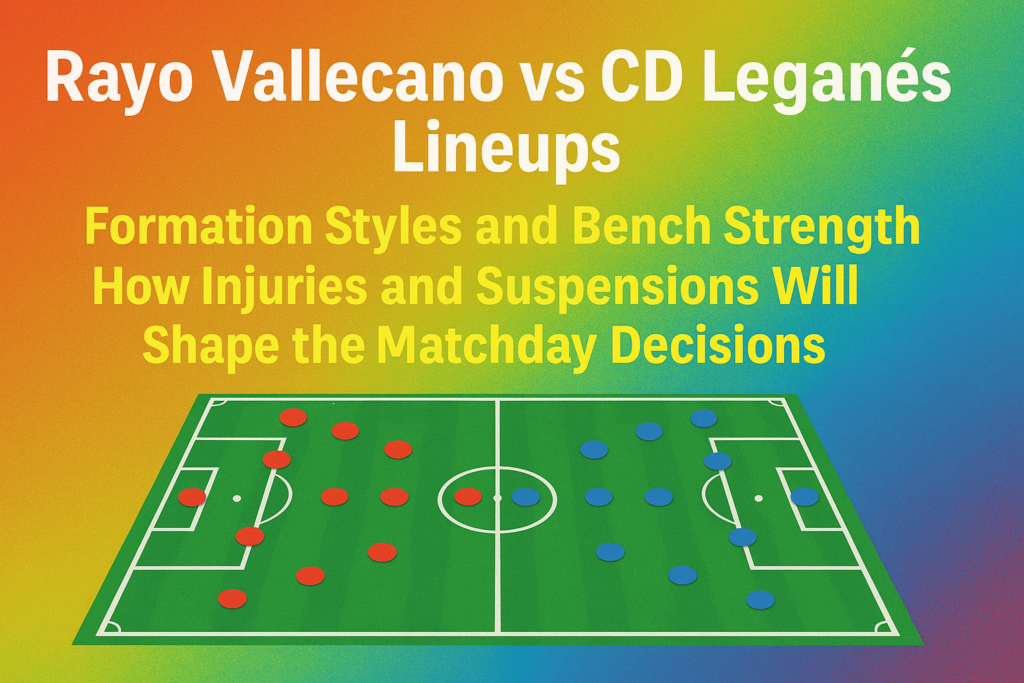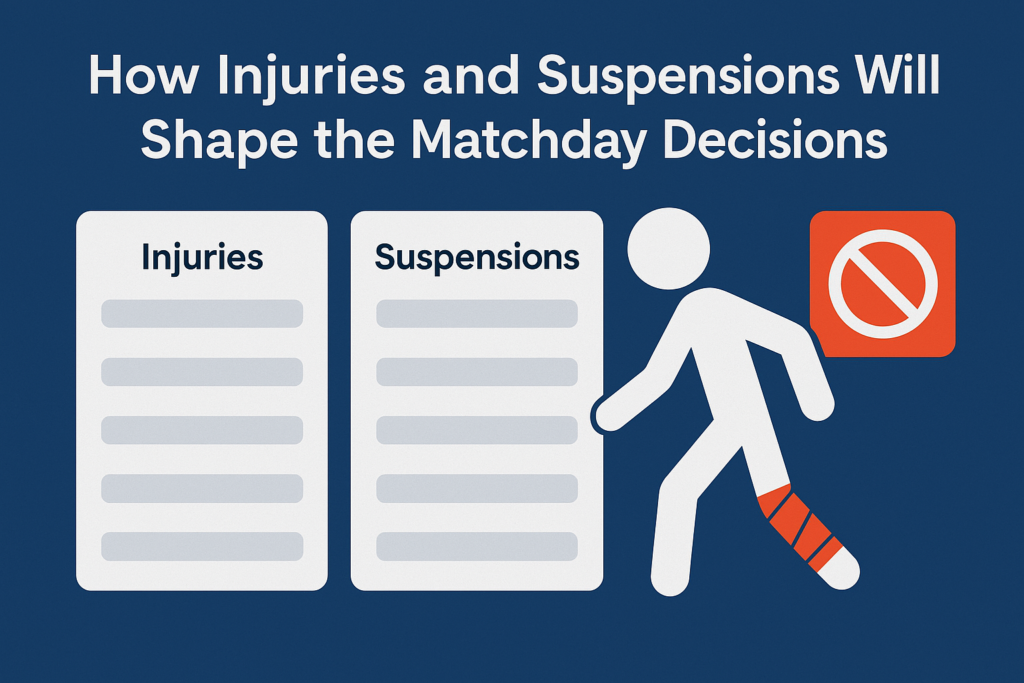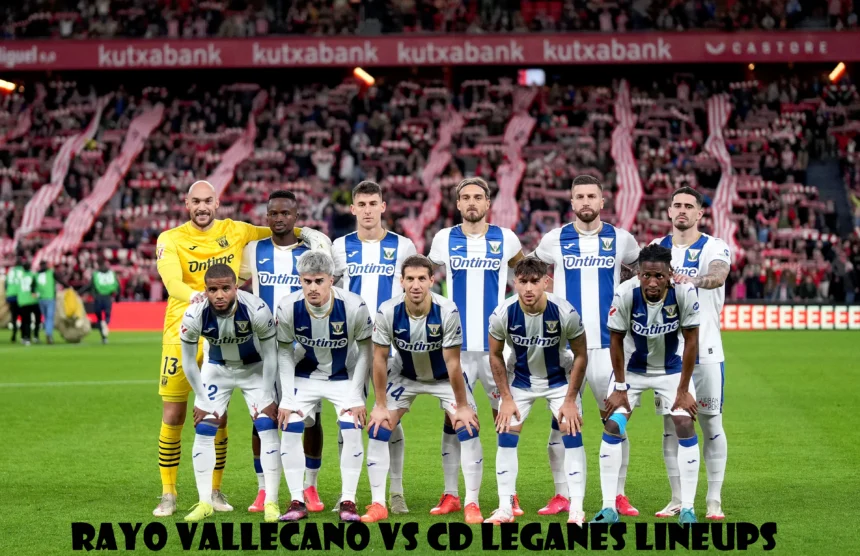The Rayo Vallecano vs CD Leganés lineups are set to play a crucial role in this exciting Madrid derby clash. Fans are eager to see how both teams structure their starting elevens to gain a tactical edge. Analyzing the Rayo Vallecano vs CD Leganés lineups gives insight into key players, formations, and game-day strategies.
Rayo Vallecano vs CD Leganés Lineups: Predicted Starting XI for Both Sides
Rayo Vallecano is expected to field their standard 4-2-3-1 formation, led by their experienced goalkeeper Stole Dimitrievski.
CD Leganés, aiming for defensive stability, will likely go with a 4-4-2 setup. Miguel de la Fuente could start up front, while the midfield might feature Gaku Shibasaki and Dani Raba for ball control.
The Rayo Vallecano vs CD Leganés lineups are shaped by recent form and past matchups. Rayo may prioritize quick transition plays, while Leganés prefers a compact midfield.
Possible Starting XI (Table):
| Position | Rayo Vallecano | CD Leganés |
| GK | Dimitrievski | Riesgo |
| LB | Espino | Miramón |
| CB | Lejeune | Omeruo |
| RB | Balliu | Nyom |
| MF | Isi Palazón | Gaku Shibasaki |
| FW | De Tomás | Miguel de la Fuente |
Tactical Variations in Rayo Vallecano vs CD Leganés Lineups
Tactically, Rayo Vallecano relies on wide overloads and overlapping fullbacks to stretch the opponent. This gives players like Isi Palazón space to create scoring chances.
Leganés tends to stay compact and break using counterattacks. Their 4-4-2 formation allows them to maintain shape and frustrate attacking teams like Rayo.
The Rayo Vallecano vs CD Leganés lineups often reflect these tactical identities, with Rayo going more offensive and Leganés opting for controlled structure.
In some matches, Leganés has shifted to a 4-2-3-1 when chasing a goal. Rayo, meanwhile, can switch to a 3-5-2 late in games to add midfield control.
Both managers are expected to stick with their core setups but may introduce variations based on in-game pressure and substitutions.
Rayo Vallecano vs CD Leganés Lineups: Formation Styles and Bench Strength
The formations provide insight into how each manager prepares the team. Rayo usually starts in a 4-2-3-1, allowing three attackers to press high up the pitch.
Leganés’s classic 4-4-2 helps them defend in two solid blocks, limiting space for creative players. This style suits games where they expect lower possession.
Bench strength can heavily influence late match outcomes. Rayo’s bench often includes wingers like Álvaro García and midfielders capable of changing tempo.
Key Bench Players (Bullet Points)
- Rayo: Álvaro García, Unai López, Camello
- Leganés: Allan Nyom, Juan Cruz, Sergio González
The Rayo Vallecano vs CD Leganés lineups are not just about starters—substitutes play a crucial role in matchday strategy, especially after 70 minutes.
Key Player Absences Impacting Rayo Vallecano vs CD Leganés Lineups
Injuries or suspensions can lead to late lineup adjustments. Rayo has had defensive issues this season due to absences in their center-back roles.
Leganés recently missed a few key midfielders, which forced changes in their usual 4-man line. The return of Shibasaki adds stability but not full depth.
The Rayo Vallecano vs CD Leganés lineups this time may lack some regular starters. It puts added pressure on backup players to deliver under intense rivalry conditions.
Such absences could also influence tactical shifts. For example, missing a central defender might lead Rayo to add a third midfielder for coverage.
Fans and analysts are closely watching pre-match updates to confirm who will be available and who may drop out last-minute.
How Injuries and Suspensions Will Shape the Matchday Decisions
Team doctors and coaching staff have a major say in final lineup decisions. Injured players might be fit but not match-ready, affecting their starting chances.
Suspensions, especially due to yellow card accumulation, can change dynamics. Both Rayo and Leganés have players walking a disciplinary tightrope.
The Rayo Vallecano vs CD Leganés lineups are likely to be finalized only after medical tests and coach consultations close to kick-off.
Injury-prone players might be named on the bench rather than risk a starting role. Tactical balance also changes with such decisions.
Both managers are experienced in adapting, but unexpected absences can alter formation choices and reduce the effectiveness of usual match strategies.
Young Talents Who Might Break into the First Team
Both teams are increasingly relying on youth development, with young players earning matchday squad appearances in recent weeks. This season presents an opportunity for emerging talents to break into the first team.
Rayo Vallecano may introduce young winger Jorge Moreno, who has shown promise in the B team. His versatility makes him a useful asset on the flanks or as a substitute attacker.
CD Leganés also has a few names pushing for inclusion, like Diego García and Naim García. Their agility and energy fit well in the high-intensity fixtures like this derby.
These rising players could earn bench spots or even surprise starts depending on training performance. Youth players bring unpredictability that could refresh the Rayo Vallecano vs CD Leganés lineups.
Clubs might also rotate younger players into the squad during tight fixture schedules, especially if key starters are fatigued or injured.
Coach Strategy: How Both Managers Approach This Clash
Managers play a key role in shaping the Rayo Vallecano vs CD Leganés lineups, especially in a rivalry game where details matter. Rayo’s coach focuses on high pressing and possession recovery.
Leganés’s approach is usually more pragmatic, with structured lines and quick transitions after turnovers. Their strategy aims to neutralize opponents’ creative threats.
Both coaches may modify their usual setups depending on the opponent’s lineup and form. Flexibility will be crucial in responding to in-game changes.
Managerial Focus Areas (Bullet Points):
- Rayo Vallecano: Pressing triggers, overlapping runs
- CD Leganés: Compact blocks, counter attacks
- Both: Emphasis on set-pieces and defensive transitions
Final decisions regarding formations and substitutes will reflect each manager’s plan to either dominate possession or disrupt the rhythm.
Comparative Analysis: Midfield Control and Defensive Depth
Midfield is often the battleground in these tightly contested derbies. Rayo prefers a three-man midfield, allowing rotations and width, while Leganés sticks to flat four lines for balance.
Defensive depth is where Leganés tends to shine, with experienced center-backs offering strong aerial presence. Rayo’s defense is more mobile, adapting to wide attacks quickly.
The Rayo Vallecano vs CD Leganés lineups will showcase this midfield and defensive contrast, with one focusing on control and the other on holding shape.
Midfield & Defense Comparison Table:
| Attribute | Rayo Vallecano | CD Leganés |
| Midfield Formation | 4-2-3-1 (fluid) | 4-4-2 (structured) |
| Defensive Strength | Mobility & pace | Strength & positioning |
| Key Midfielders | Unai López, Trejo | Shibasaki, Undabarrena |
Winning the midfield battle can decide the flow of the match, forcing one team into chasing or defending longer than intended.
Set-Piece Experts and Goal Threats in the Upcoming Match
Set-pieces will be a decisive factor in the outcome. Rayo’s Isi Palazón is known for delivering dangerous corners and free kicks into the box.
Leganés has strength in aerial duels with players like Omeruo and Nyom offering height advantage during attacking set-plays.
The Rayo Vallecano vs CD Leganés lineups will likely include players selected for their contributions in dead-ball scenarios.
While open play will matter, teams often rely on set-piece execution to break deadlocks, especially in tightly defended matches.
Expect defenders and midfielders to make key forward runs during corners and indirect free kicks, aiming to convert rare chances into goals.
Final Thoughts
The final selections in the Rayo Vallecano vs CD Leganés lineups will aim to balance form, fitness, and tactical needs. Both teams must also think ahead in terms of substitutions.
Having a strong bench with pace and creativity is crucial. Rayo may save Álvaro García and Camello for second-half impacts, while Leganés might use Juan Cruz to boost midfield late in the game.
Substitutions can flip momentum, especially in a close match. Coaches often use the first change as early as the 60th minute to exploit tiring defenses.
Lineup balance also depends on the ability to shift formations mid-game. Tactical substitutions give coaches flexibility in response to how the match unfolds.
Ultimately, success hinges on both the starting XI and the ability to adapt through timely changes and bench usage.
Also Read:
fashionisk .com Global Reach: How to Build Your Wardrobe with Budget-Friendly, Stylish Picks












